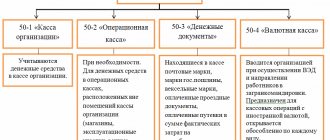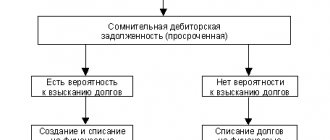Specifics of application of account 52 “Currency accounts”
Account 52 - Currency accounts The chart of accounts (approved by order of the Ministry of Finance of the Russian Federation dated October 31, 2000 No. 94n) is intended to reflect accounting transactions with non-cash foreign currency funds.
Read about the Chart of Accounts in the article.
Current accounts on which such transactions are carried out can be opened in both Russian and foreign banks. This circumstance determines the allocation of two sub-accounts on account 52, intended for accounting for funds in banks:
- Russian - subaccount 52-1;
- foreign - subaccount 52-2.
Just as for ruble accounts, for foreign currency accounts reflected in accounting account 52, the following are required:
- organization of separate analytics not only for banks, but also for each account opened in this bank;
- using bank statements and payment documents attached to them as a basis for carrying out an operation.
Features of accounting on account 52 are due to the fact that:
- a foreign currency account opened in a Russian bank is actually represented by two accounts: transit (in which the funds are kept until the recipient submits documents identifying the payment to the credit institution) and current;
- According to accounting rules, accounting transactions must be reflected in ruble equivalent, and this requires: keeping records in parallel in two currencies (foreign and rubles);
- mandatory recalculation of currency balances on the date of the transaction and on the reporting date;
At the same time, you should remember that there is a ban (clause 1 of Article 9 of the Law “On Currency Regulation...” dated December 10, 2003 No. 173-FZ) on carrying out currency transactions between residents of the Russian Federation (with some exceptions). However, this does not mean that account 52 will show only settlements with non-residents and the results of recalculation of the ruble equivalent of foreign currency amounts.
Read about the rules that govern currency transactions in the Russian Federation in the publication “Currency transactions: concept, types, classifications.”
What is it for - characteristics
If an organization makes non-cash transactions in foreign monetary units with its counterparties, it uses a foreign currency bank account through which the corresponding operations are carried out - payments are made, cash receipts are received, and currency is converted.
Read how to open a foreign currency account here.
All incoming and outgoing transactions carried out by an organization on its foreign currency bank accounts must be confirmed by the necessary papers - payment documents (orders for wire transfers, applications for the purchase or sale of currency, other documents), as well as bank statements.
Supporting documentation reflects and certifies the non-cash movement of foreign currency, its information is used for accounting of relevant transactions.
If we talk about the purpose of account 52 in accounting, it should be noted that it records non-cash monetary transactions performed by the company in foreign currency.
Correct reflection of such transactions is not possible without strict compliance with the rules and regulations provided for by certain provisions of the current domestic legislation.
Business entities that take part in foreign economic activity, that is, cooperate with foreign buyers and suppliers, must open and use bank foreign currency accounts.
Accounting for non-cash transactions in foreign monetary units is carried out by the company using accounting account 52.
Features of using 52 accounts in accounting:
- Great importance is always attached to the date of currency conversion into domestic rubles.
- The monetary value of an asset/liability expressed in foreign currency is recalculated into Russian rubles at the official exchange rate of this monetary unit to domestic rubles established by the Central Bank of the Russian Federation.
- The difference in rates, which often arises during recalculation, is taken into account by the organization for the corresponding reporting period. Differences in exchange rates can be positive (related to non-operating income) or negative (taken into account in non-operating costs).
Active or passive
Account 52 is active in the organization’s accounting.
In other words, debit records all non-cash foreign exchange receipts (for example, a company’s purchase of foreign currency, receipt of revenue from customers, return of money from a supplier, raising borrowed funds).
The loan reflects non-cash write-offs and expenditures of foreign currency (this may be the sale of available foreign currency funds, repayment of relevant loans, payments to counterparties).
Subaccounts
Current bank accounts, through which an economic entity that is a resident of the Russian Federation carries out non-cash currency transactions, can be opened both in domestic banks and in foreign financial institutions.
Consequently, within account 52 the following subaccounts can be allocated:
- subaccount 52-1 (for accounts opened by a company within the territorial boundaries of the Russian Federation);
- subaccount 52-2 (for accounts opened by a company outside the territorial borders of the Russian Federation).
Analytical accounting is carried out separately within the above-mentioned subaccounts for each currency used, for each servicing bank, for each account in a particular financial institution.
Example:
Subaccount 52-1-1/1 can take into account the movement of USD on a specific current account opened by a business entity in a specific bank directly operating in the territory of the Russian Federation.
Accounting Features
Credit and financial institutions, as a rule, open for their clients - business entities carrying out settlement transactions in foreign monetary units - not one, but two bank foreign currency accounts:
- Current – to record the organization’s cash receipts in foreign currency (for example, the revenue of an exporting company).
- Transit - for depositing received foreign currency funds, in respect of which the account owner - the recipient of the money - must provide the servicing bank with papers that make it possible to clearly establish the purpose of these funds. It can also be used to sell foreign currency earnings.
The rules of domestic accounting provide that foreign exchange transactions recorded under account 52 must be reflected in the equivalent of the national monetary unit (Russian ruble).
This requirement implies compliance with the following conditions:
- the company accounts for its foreign exchange transactions in two monetary units simultaneously (in Russian rubles and in the corresponding foreign currency);
- Fund balances are necessarily recalculated by the business entity on the date of the transaction and on the date of reporting.
In addition, it should be remembered that foreign currency in a bank account can be used not only as a means of non-cash payments, but also as an item of purchase and sale (conversion).
It is also important to know that there is an official ban on making payments in foreign currency between Russian residents (with the exception of some typical situations).
However, the presence of such a prohibition does not mean at all that the account under consideration 52 reflects only settlements with non-resident counterparties and monetary results from the conversion of currency amounts into the ruble equivalent.
The accounting plan provides for the possibility of correspondence between account 52 and most other accounting accounts. Thus, taking into account the current ban on currency transactions with resident counterparties, it can be noted that non-cash funds in foreign monetary units can be successfully used for the following purposes:
- monetary settlements between the organization and its divisions and founders;
- providing financial loans to third parties;
- raising borrowed funds from various lenders;
- settlements with various counterparties;
- making tax payments;
- opening and using special accounts to save/increase money;
- payment of salaries to employees;
- financing of travel expenses.
Typical transactions for foreign exchange transactions
| Operation | Debit | Credit |
| Currency in cash is transferred from the company's cash desk to an account at a financial institution | 52 | 50 |
| Purchase of foreign currency by an organization | 52 | 57 |
| Receiving foreign currency earnings from a non-resident buyer | 52 | 62 |
| Raising a loan | 52 | 67(66) |
| Receiving a founding contribution | 52 | 75 |
| Receipts from other counterparties | 52 | 76 |
| Foreign currency funds came from a division of the company | 52 | 79 |
| A positive exchange rate difference is recorded | 52 | 91/1 |
| Currency in cash arrived at the company's cash desk from an account at a financial institution | 50 | 52 |
| Currency for sale (sale) is listed | 57 | 52 |
| Payment for a consignment of goods to a non-resident supplier | 60 | 52 |
| The loan is repaid (principal, interest) | 67(66) | 52 |
| The founder is returned funds in foreign currency | 75 | 52 |
| Services of other contractors are paid | 76 | 52 |
| Funds are transferred to a division of the company | 79 | 52 |
| Negative exchange rate difference is fixed | 91/2 | 52 |
Typical transactions for account 52
In the description of account 52 in the Chart of Accounts, almost all accounts appearing in the Chart of Accounts are listed as accounting accounts in correspondence with which postings are allowed. This suggests that foreign currency funds can be used for the same types of transactions as money stored in ruble accounts (subject to the ban on settlements with residents), that is:
- for payment of travel allowances and salaries;
- saving and increasing funds using special accounts;
- settlements with counterparties and payment of taxes;
- issuing loans and obtaining borrowed funds;
- settlements with founders and divisions.
However, from this entire set you can select those correspondence that characterize typical transactions for account 52. These are, for example:
- Dt 52 Kt 62 - receipt of funds from a foreign buyer;
- Dt 60 Kt 52 - payment to a foreign supplier or bank for services;
- Dt 91 Kt 52 and Dt 52 Kt 91 - a reflection of negative or positive exchange rate differences;
- Dt 57 Kt 52 and Dt 52 Kt 57 - accounting for the amount of foreign currency when selling or buying foreign currency;
- Dt 50 Kt 52 - withdrawal of currency for issuance to a business traveler abroad;
- Dt 58 Kt 52 - issuing a loan in foreign currency;
- Dt 52 Kt 66 (67) and Dt 66 Kt 52 - receipt and repayment of a foreign currency loan, as well as payment of interest on it (if interest is paid in foreign currency);
- Dt 52 Kt 75 and Dt 75 Kt 52 - making a contribution to the capital company by a foreign founder and paying dividends to him.
Salary payments from a foreign currency account are possible for employees performing their functions abroad (Dt 70 Kt 52).
Read about the nuances of accounting for currency transactions in the material “Accounting for currency transactions (PBU, postings).”
Account 52: accounting with an example
Info LLC sells 300 Brazilian reais from a foreign currency account. Transaction date – 07.10.17, Central Bank rate for the Brazilian real on that day – 18.3039 rubles, bank rate – 18.3030 rubles, bank commission – 180 rubles.
The following entries are generated in accounting:
- D57 – K52 – funds in foreign currency were allocated for sale in the amount of 5491.17 rubles. (300 reais x 18.3039).
- D51 - K91.1 - the bank carried out the exchange and credited the company with proceeds from the sale of currency in the amount of 5490.90 rubles. (300 x 18.3030).
- D91.2 – K51 for 180 rubles. when paying a commission to the bank.
- D91.2 – K57 to reflect the resulting negative exchange rate difference of 0.27 rubles. ((18.3039-18.3030) x 300).
- D91.2 - K57 at the time of writing off foreign currency funds in the amount of 5491.17 rubles.
Results
On account 52, accounting of foreign currency funds available in accounts in Russian and foreign banks is carried out. In comparison with ruble accounts, currency accounting has a number of features due to:
- rules for opening an account;
- mandatory parallel reflection of currency amounts in rubles;
- the ability to buy and sell currency.
At the same time, for foreign currency accounts it is possible to use the same set of account correspondence as for settlements in rubles.
These possibilities will be limited by a ban on currency payments between residents. You can find more complete information on the topic in ConsultantPlus. Full and free access to the system for 2 days.
Purchasing foreign currency: transactions, exchange rate differences
| ★ Best-selling book “Accounting from scratch” for dummies (understand how to do accounting in 72 hours) > 8,000 books purchased |
How is currency purchased?
In order to buy foreign currency, an organization transfers a certain amount of money in rubles to the bank from its ruble current account. At the same time, in accounting, this transfer is reflected by posting D57 K51 . Account 57 “Transfers in transit” – intermediate between 51 “Current account” and 52 “Currency accounts”. The money has been debited from the current account, but we cannot credit it to the foreign currency account yet, since the bank has not yet transferred the currency to us. To prevent this money from being lost or forgotten, an intermediate account is used. 57 “Translations on the way.”
After the organization has transferred the required amount of money to the bank in rubles, the bank purchases the required amount of foreign currency and transfers it to the enterprise’s foreign currency account (the currency accounted for is converted into rubles at the rate of the Central Bank of Russia effective on the date of enrollment). Accounting entry D52 K57 .
Account balances 57 are transferred back to the account (posting D51 K57 ).
For carrying out an operation to purchase foreign currency, the bank withholds a commission, the amount of which is applied to the increase in the cost of acquired material assets or as part of operating expenses. The posting reflecting the payment of the commission has the form: D91/2 K51 , where in account 91 subaccount 2 operating expenses are taken into account.
Purchased foreign currency is accounted for at the official exchange rate of the Central Bank of Russia in effect on the date of its receipt.
At the same time, the rate used when purchasing foreign goods may differ from the official rate of the Central Bank of the Russian Federation. The resulting difference is called the financial result from the purchase of currency.
If the official exchange rate is less than the purchase rate, then in accounting the resulting difference is reflected as part of operating expenses. ( D91/2 K57 - negative difference).
If the official rate is higher than the purchase rate, then the difference is reflected in operating income ( D57 K91/1 - positive difference).
At the time of payment for foreign goods, the supplier must recalculate the currency at the rate of the Central Bank of the Russian Federation on the date of payment:
If the rate on the date of payment to the supplier is higher than that of the Central Bank of the Russian Federation on the date the currency is credited to the account. 52, then a positive exchange rate difference arises, which is reflected in other income by posting D57 K91/1 .
If the exchange rate of the Central Bank of the Russian Federation on the date of payment is lower than on the date of crediting the currency to the foreign exchange account, then a negative exchange rate difference arises, which is reflected as part of other expenses by posting D91/2 K57 .
| ★ Best-selling book “Accounting from scratch” for dummies (understand how to do accounting in 72 hours) > 8,000 books purchased |












